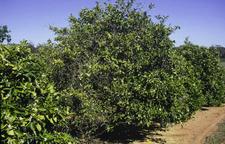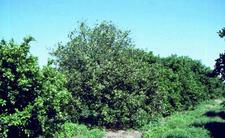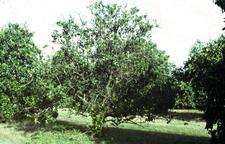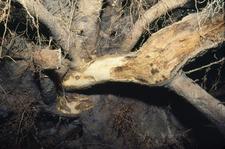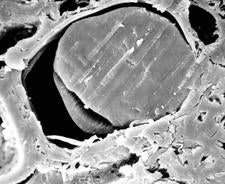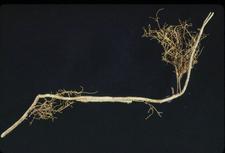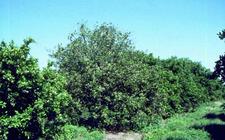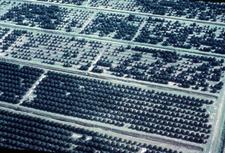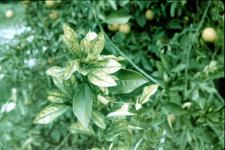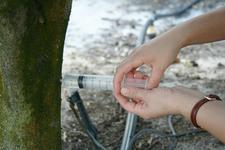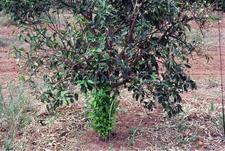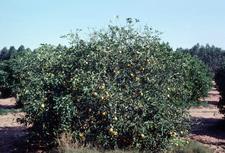Citrus Blight
HISTORY, DISTRIBUTION AND IMPORTANCE
Citrus blight is one of the most important decline diseases of citrus in the world. It is responsible for the loss of about 500,000 trees annually in Florida and perhaps as many as 10 million trees in Brazil every year. This disease occurs widely in many countries in Central and South America as well as in South Africa, Australia, and other areas. Blight is rare in arid, winter-rainfall areas such as the Mediterranean, California, and inland areas of Australia.
A disease referred to as blight has been studied in Florida for over 100 years. This disease was commonly observed on trees on sour orange rootstock in the coastal citrus areas of Florida. Since it was not characterized at the time, it is not known whether this disease is the same as the one now known as blight. Citrus blight in the early days in Florida was known variously as young tree decline (even though it only affected bearing trees), sandhill decline, and rough lemon decline. All of these names refer to the same disease. Only in the 1970s and 1980s were studies conducted that led to clear differentiation of blight from other decline diseases.
NAME OF DISEASE AND SYNONYMS
Blight is known as declinio in Brazil, declinamiento in Argentina, and marchitamiento repentino in Uruguay.
Abbreviation: CB for Citrus Blight.
SYMPTOMATOLOGY
Blight is a wilt and decline disease of citrus trees. The disease does not occur on non-bearing trees and trees may be 8-10 years old when decline is first noted. However, it has been observed on trees as young as 4 years of age. The first symptom of the disease is a mild wilt and grayish cast to the canopy with some leaf loss (CB. 01). These symptoms are followed by more severe, permanent wilt, leaf drop, and twig dieback (CB. 02, 03). Root and trunk sprouts are common on affected trees (CB. 03). Symptoms of zinc and other nutritional deficiencies are common on blight-affected trees. Trees with blight seldom die, but usually become unproductive within a year. As the canopy declines, fibrous roots are lost and eventually major roots may be rotted as well (CB. 04).
Symptoms are the result of blockage of xylem vessels with amorphous plugging material (CB. 05). Early studies found fibrous plugs in the vessels of citrus trees, but these were found in trees affected by other decline diseases as well.
CAUSAL AGENT: DESCRIPTION AND PROPERTIES
The causal agent of blight is unknown. Microscopic studies have failed to reveal the presence of any obvious pathogen. Early studies suggested that Physoderma was present in blighted trees, but these structures were actually fibrous plugs in xylem vessels. Some unusual filamentous structures have been found in xylem extracts of blighted trees, but the nature of these has never been elucidated.
Soil-borne organisms and soil problems also have been suggested as causes of blight. Fusarium solani has been extensively studied in relation to the disease. However, it has never been conclusively demonstrated that this fungus is capable of causing the disease in the field. Transmission tests, using large volumes of soil from beneath blighted trees failed to transmit the disease to healthy trees. The effect of soil pH and other edaphic factors, liming and fertilization, and other management practices as factors in the disease has been extensively studied. Blight has been attributed to clay layers in the soil, to liming of groves, and to "modern agricultural practices". However, blight occurs on virtually every soil type where citrus is grown and under a wide variety of cultural practices. The disease has never been reproduced in the field or its incidence reduced by changing cultural practices.
Initially, it was proposed that blight was caused by a variant of tristeza virus that affected trees on rough lemon rootstock. Xylella fastidiosa has been detected in blight-affected citrus trees and has also been suggested as a causal agent. Symptoms somewhat resemble diseases caused by X. fastidiosa and the bacterium is widespread in other plants in areas with blight. Symptoms resembling blight have been produced in young trees inoculated with X. fastidiosa. However, the quantities of bacteria usually associated with other diseases caused by X. fastidiosa are not present in blighted citrus. Despite some circumstantial evidence for X. fastidiosa as the causal agent, no conclusive evidence has been reported. The presence of citrus variegated chlorosis (CVC) in Brazil, caused by X. fastidiosa, and the lack of association of blight and CVC argues against X. fastidiosa as a cause of blight.
Early work on graft-transmission was largely unsuccessful. Buds from blight-affected trees produced healthy trees whether grafted onto healthy seedlings or onto sprouted roots from blighted trees. Nevertheless, subsequent attempts at root graft transmission were successful. When bearing trees were connected by root grafts directly to blighted trees or root pieces from blight-affected trees were side- or cleft-grafted to the roots of healthy trees (CB. 06) they declined in 1½ to 3 years (CB. 07). Inoculated trees had all of the characteristic symptoms of blighted trees–typical symptoms, elevated zinc in trunk wood, poor water uptake, and amorphous plugs in the xylem. Similar experiments with above-ground portions of the tree have failed to transmit blight.
Two proteins, p12 and p35 have been found in blighted trees. Neither the p12 or p35 proteins appear to be associated with a pathogen in diseased trees. p35 was found to be similar to a b-1,3-glucanase and has not been further investigated. The nucleotide sequence of the p12 gene is very close to that of another hypothetical protein in Arabidopsis. Sense and antisense p12 genes have been transformed into citrus in an attempt to elucidate the role of this gene in disease development. Recently, an idaeovirus, similar to raspberry bushy dwarf virus, has been associated with citrus blight.
The causal agent for blight remains undetermined. The only conclusion that can be drawn is that it is a systemic infectious agent that is limited to the root system.
HOST RANGE
Sensitive, tolerant and resistant rutaceous and non-rutaceous species
Citrus blight can occur on all common citrus cultivars, on trees on all rootstocks, and on seedling trees, but is not known to affect other plants. Rootstocks differ in the age at which trees become affected, but once affected symptom severity is similar on all rootstocks. Trees on rough lemon, Rangpur lime, trifoliate orange, and Carrizo citrange are especially susceptible, whereas those on sour orange, sweet orange, and Swingle citrumelo are most tolerant. Losses are often extensive on the most susceptible rootstocks before many trees decline on the tolerant stocks (CB. 08). However, trees on sweet orange are highly susceptible to Phytophthora diseases and those on sour orange are highly susceptible to tristeza.
EPIDEMIOLOGY
When the disease first appears in a citrus grove, its distribution is random. With time, the distribution may be more clustered (CB. 09), suggesting that affected trees may be a source of inoculum. However, affected trees are not so tightly clustered that a soil-borne pathogen would be indicated. In some cases, however, there is spread down rows suggesting that transmission may be occurring by root grafts. Disease progress in Florida groves is often linear which would suggest an abiotic agent as the cause. However, growers in Florida remove affected trees quickly which may slow disease progress. In Brazil, where declining trees are not removed, disease progress is often exponential.
DIAGNOSIS
Blight is a decline disease and can easily be confused with many other diseases such as tristeza and declines caused by nematodes, Phytophthora, or other soil-borne diseases. It is a vascular disease and trees often wilt more readily than trees affected by other diseases. Root and trunk sprouts are more common than on trees affected by other declines. Zinc and other micronutrient deficiency patterns are common on blighted trees, but not diagnostic (CB. 10).
Several techniques have been described that can provide accurate diagnoses. The syringe test for water uptake is commonly used in the field (CB. 11). A small hole is drilled into the trunk of the tree and a syringe is used to attempt to inject water into the trunk. Blight trees will not take up water, whereas those affected by other declines and healthy trees usually absorb water readily. The zinc concentration of trunk wood in blight-affected trees is high, but must be compared to the concentration in nearby healthy trees in the same grove since concentrations may vary widely between locations. Serological tests for the 12 kD and other proteins that are unique to blighted trees are used commonly to identify trees affected by blight.
Diagnostic tests were important in demonstrating that other decline diseases such as declinio in Brazil (CB. 12) and declinamiento in Argentina (CB. 13) were the same as citrus blight.
CONTROL
Blight-affected trees should be replaced with trees on tolerant rootstocks. Sweet orange, sour orange, Swingle citrumelo, and to a lesser extent Cleopatra mandarin, are more tolerant to the disease. Tolerance to the disease is expressed as the age at which symptoms usually appear and as reduced incidence. Once trees on any rootstock develop the disease, they usually decline within a short time.
SELECTED REFERENCES
Brlansky, R. (2000) Blight. p. 65-66. In L.W. Timmer, S.M. Garnsey, & J.H. Graham, eds. Compendium of Citrus Diseases, 2nd edition. APS Press, St. Paul, MN.
Derrick, K.S., L.W. Timmer (2000) Citrus blight and other diseases of recalcitrant etiology. Annu. Rev. Phytopathol. 38, 181-205.
Derrick, K.S., R.F. Lee, R.H. Brlansky, L.W. Timmer, B.G. Hewitt, G.A. Barthe (1990) Proteins associated with citrus blight. Plant Dis. 74, 168-170.
Derrick, K.S., G.A. Barthe, B.G. Hewitt, R.F. Lee, L.G. Albrigo (1992). Detection of citrus blight by serological assays. Proc. Fla. State Hortic. Soc. 105, 26-28.
Lee, R.F., L.J. Marais, L.W. Timmer, J.H. Graham (1984) Syringe injection of water into the trunk: a rapid diagnostic test for citrus blight. Plant Dis. 68, 511-513.
Timmer, L.W., R.H. Brlansky, K.S. Derrick, R.F. Lee (1991) Transmission of citrus blight by root graft inoculation. p. 244-249. In P. Moreno, L.W. Timmer, & J.V. da Graça, eds. Proc. 11th Conf. Int. Organ. Citrus Virologists. IOCV, Riverside, CA.
Timmer, L.W., R.F. Lee, R.H. Brlansky, J.H. Graham, L.G. Albrigo, K.S. Derrick, D.P.H. Tucker (1992) The infectious nature of citrus blight. Proc. Fla. State Hortic. Soc. 105, 21-26.
Tucker, D.P.H., R.F. Lee, L.W. Timmer, L.G. Albrigo, R.H. Brlansky (1984) Experimental transmission of citrus blight. Plant Dis. 68, 979-980.
Wheaton, T.A. (1985) Citrus blight: One hundred years of research in Florida. Citrus Ind. 66(2), 25-27, 30-32.
Wutscher, H.K., M. Cohen, R.H. Young. (1977) Zinc and water-soluble phenolic levels in the wood for the diagnosis of citrus blight. Plant Dis. Rep. 6, 572-576
Prepared (2006) by L.W. Timmer and R.H. Brlansky
Department of Plant Pathology
University of Florida, IFAS
Citrus Research and Education Center
700 Experiment Station Road
Lake Alfred, FL 33850
(USA)
Click any image to see it larger.
PHOTOS |
LEGENDS AND AUTHORS |
|---|---|
|
Tree affected by citrus blight in mild decline (Florida). Photo by L.W. Timmer. |
|
|
Tree affected by citrus blight in moderate decline (Florida). Photo by R.H. Brlansky. |
|
|
Tree affected by citrus blight in advanced decline showing trunk sprouts (Florida). Photo by L.W. Timmer. |
|
|
Decay of major roots on a blight-affected tree in advanced decline (Florida). Photo by J.H. Graham. |
|
|
Electron micrograph of an amorphous plug in a vessel in a blight-affected tree (Florida). Photo by R.H. Brlansky. |
|
|
Side graft on the root of a healthy tree for transmission of citrus blight (Florida). Photo by L.W. Timmer. |
|
|
Tree affected by citrus blight that had been root-graft inoculated 1 ½ years previously (Florida). Photo by L.W. Timmer. |
|
|
Blight-affected blocks on rough lemon rootstock (above) and healthy trees on sour orange rootstock (below) (Florida). Photo by S.M. Garnsey. |
|
|
Aerial view of a Valencia orange grove on rough lemon rootstock showing the distribution of blight-affected trees (Florida). Photo by E.P. DuCharme. |
|
|
Zinc deficiency symptoms on a sweet orange tree affected by citrus blight (Florida). Photo by M. Cohen. |
|
|
Syringe injection test for citrus blight. Blight-affected trees take up no water no mater how much pressure is applied (Florida). Photo by R.H. Brlansky. |
|
|
Tree in Brazil affected by decline showing symptoms and sprouts from rootstock (Brazil). Photo by L.W. Timmer) |
|
|
Tree affected by declinamiento in Argentina (Argentina). Photo by L.W. Timmer. |

